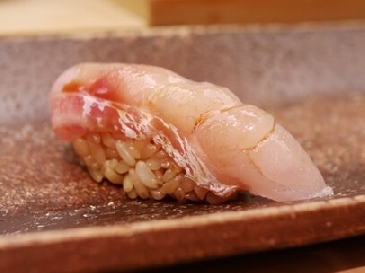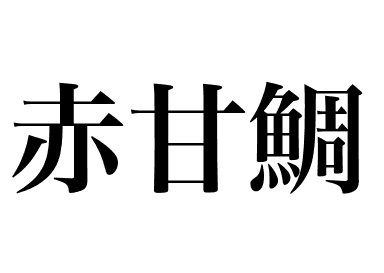White flesh


Horsehead (Akaamadai)
【Nigiri sushi: Shiromi】
Dubbed as ”noble lady” of white fish. Seasonal fatty meat is sweet and tasty. Shiro-amadai is more suitable for sushi than aka-amadai and ki-amadai due to its less amount of water content in meat.
Aka-amadai: Inhabits sandy mud bottoms from central Honshu to the East China Sea, Jeju Island, and the South China Sea, at depths of 30 to 150 m. The body length is 45 cm. The spawning season runs from June to November. They lay their eggs on the seafloor near coasts at depths of 70 to 100 m. The peak season is winter. Aka-amadai is the most widely distributed type of Amadai.
Aka-amadai is called “Guji” in the Kansai region and is a vital part of Kyoto cuisine. In sushi restaurants, Aka-amadai is shortened to Amadai. It is one of the wateriest fish, so it is important to prepare it by removing excess water and concentrating the umami. Sprinkle salt on the fish and let it sit for about 30 minutes to an hour. Then rinse off the water and salt that has come out before using.
Once the water is removed, the amadai has a distinct flavor and sweetness, and with its sticky texture, it is perfect for sushi topping. It can be served as it is, but since the fat under the skin is a delicious fish, it can also be boiled (Yubiki) or seared (Yakishimo) on the skin. Some restaurants further kobujime it.
Shiro-amadai: Inhabits sandy mud bottoms from central Honshu to the East China Sea, Busan, and the South China Sea, at depths of 30 to 100 m. The body is an overall whitish color. The body length is 60 cm. The peak season is winter.
Ki-amadai: Inhabits sandy mud bottoms from central Honshu to the East China Sea at depths of 30 to 300 m. The “Ki” part of its name means “Yellow” in Japanese, and just as the name describes, both its dorsal fin and tail fin are a yellowish color. The body length is 35 cm. The peak season is winter. This fish is rarely seen in Toyosu Market.
Also called White horsehead (Shiroamadai) or Horse head (akaamadai) or Sweet perch (akaamadai) or Japanese tilefish (akaamadai) or Yellow horsehead (kiamadai).
【Substitute fish】
・Kingklip comes from the open waters of South Africa. Their bodies reach lengths of 1.5 m and they live up to 500 m deep in the sea. The appearance is completely different from Amadai, but due to the fact that it is a white fish with low fat content and a light, delicious flavor, it can masquerade as Amadai. This fish is extremely popular for consumption in Argentina and Chile. In Japan, Amadai is enjoyed either grilled with salt or steamed. On the other hand, Kingklip is prepared in a western style, either fried or prepared as meuniere. There was a time when it was presented as “Aburi Amadai” or “Kobujime (Kelp-marinated) Amadai” at conveyor belt sushi.
・Warty dory (Allocyttus verrucosus (Gilchrist, 1906))
【Related contents】
What is Shirakawa?
List of White flesh fish (Shiromi)
(Revision date: April 16, 2024)
Main production area
Yamaguchi Fukui Ishikawa Shimane
Famous production area
Season
Autumn-Winter

